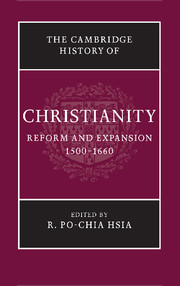Book contents
- Frontmatter
- Part I Luther and the Holy Roman Empire
- Part II The Second Reformation
- Part III Catholic Renewal
- Part IV Resolving Confessional Conflicts
- Part V Religion, Society, and Culture
- Part VI Christianity and Other Faiths
- 26 Christianity and Judaism
- 27 The naturalization of Andean Christianities
- 28 Between Islam and Orthodoxy: Protestants and Catholics in south-eastern Europe
- 29 Christianity shaped by the Chinese
- 30 Reception of Hinduism and Buddhism
- Bibliography
- Index
- References
28 - Between Islam and Orthodoxy: Protestants and Catholics in south-eastern Europe
from Part VI - Christianity and Other Faiths
Published online by Cambridge University Press: 28 March 2008
- Frontmatter
- Part I Luther and the Holy Roman Empire
- Part II The Second Reformation
- Part III Catholic Renewal
- Part IV Resolving Confessional Conflicts
- Part V Religion, Society, and Culture
- Part VI Christianity and Other Faiths
- 26 Christianity and Judaism
- 27 The naturalization of Andean Christianities
- 28 Between Islam and Orthodoxy: Protestants and Catholics in south-eastern Europe
- 29 Christianity shaped by the Chinese
- 30 Reception of Hinduism and Buddhism
- Bibliography
- Index
- References
Summary
The Ottoman Empire, which in the fourteenth and fifteenth centuries had conquered one after another of the Balkan states, pushed the imperial frontier forward to the environs of Vienna. At the Battle of Mohács in 1526, the Turks defeated the Hungarian army and during the following decades the Turkish province of Hungary was established around the former royal Hungarian capital of Buda. The frontier of the Ottoman Empire — and thus of Islam — reached to the very heart of Europe. Meanwhile, in the eastern half of the medieval Kingdom of Hungary, a new state was created: the Principality of Transylvania, which existed from 1556 until 1690 as a vassal of the sultan. Nevertheless, in spite of the Ottoman conquest and following Islamization of south-eastern Europe, a large Catholic and Orthodox population lived in the Turkish provinces. In the world history of Reformation, the success of the Lutheran, Calvinist, and antitrinitarian churches in the lands of Islam, in the Ottoman Empire, represents an interesting case.
In the sixteenth century, Muslims still formed minorities in all of the European provinces of the Ottoman Empire. From Buda to Istanbul and from Sarajevo to Sofia, many Catholics were living in these territories; in Bosnia they were particularly numerous. In the Balkan territories, however, most Christians were Orthodox; since the Reformation had arisen within Rome-based Latin Christianity, Protestants were rare here. In Moldavia and Wallachia, two vassal principalities of the sultan, most people were Orthodox. However in Moldavia, Catholics and, in the sixteenth century, Protestants were also quite numerous.
- Type
- Chapter
- Information
- The Cambridge History of Christianity , pp. 536 - 557Publisher: Cambridge University PressPrint publication year: 2007



